摘要:今天给大家介绍一个很酷的 Python 手绘风格可视化神包:cutecharts和 Matplotlib 、pyecharts 等常见的图表不同,使用这个包可以生成看起来像手绘的各种图表,在一些特殊场景下使用效果可能会更好。GitHub 地...
今天给大家介绍一个很酷的 Python 手绘风格可视化神包:cutecharts
和 Matplotlib 、pyecharts 等常见的图表不同,使用这个包可以生成看起来像手绘的各种图表,在一些特殊场景下使用效果可能会更好。
GitHub 地址:
https://github.com/chenjiandongx/cutecharts
它的画风是这样的:
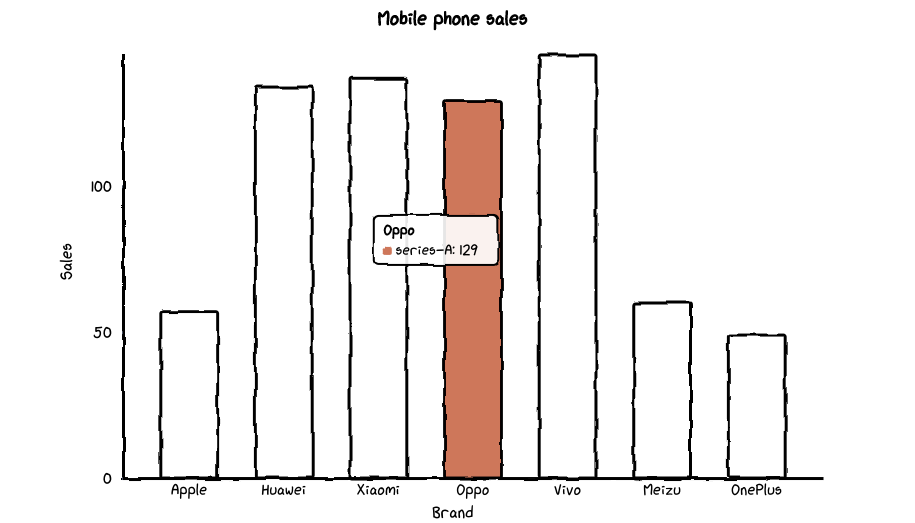
cutecharts是由pyecharts作者chenjiandongx开源的一个轻量级的项目;
目前支持Bar,Line,Pie,Radar,Scatter五种图表;
支持Page组合图表;
pip install cutecharts;
支持的参数直接参考源码中的注释就好~
def set_options( self, labels: Iterable, x_label: str = "", y_label: str = "", y_tick_count: int = 3, legend_pos: str = "upLeft", colors: Optional[Iterable] = None, font_family: Optional[str] = None, ): """ :param labels: X 坐标轴标签数据 :param x_label: X 坐标轴名称 :param y_label: Y 坐标轴名称 :param y_tick_count: Y 轴刻度分割段数 :param legend_pos: 图例位置,有 "upLeft", "upRight", "downLeft", "downRight" 可选 :param colors: label 颜色数组 :param font_family: CSS font-family """
def add_series(self, name: str, data: Iterable): """ :param name: series 名称 :param data: series 数据列表 """from cutecharts.charts import Line# 虚假数据x_data = ["Apple", "Huawei", "Xiaomi", "Oppo", "Vivo", "Meizu", "OnePlus"]y_data_1 = [57, 134, 137, 129, 145, 60, 49]y_data_2 = [114, 55, 27, 101, 125, 27, 105]
chart = Line("Mobile phone sales")chart.set_options( labels=x_data, x_label="Brand", y_label="Sales",)chart.add_series("series-A", y_data_1)chart.add_series("series-B", y_data_2)chart.render_notebook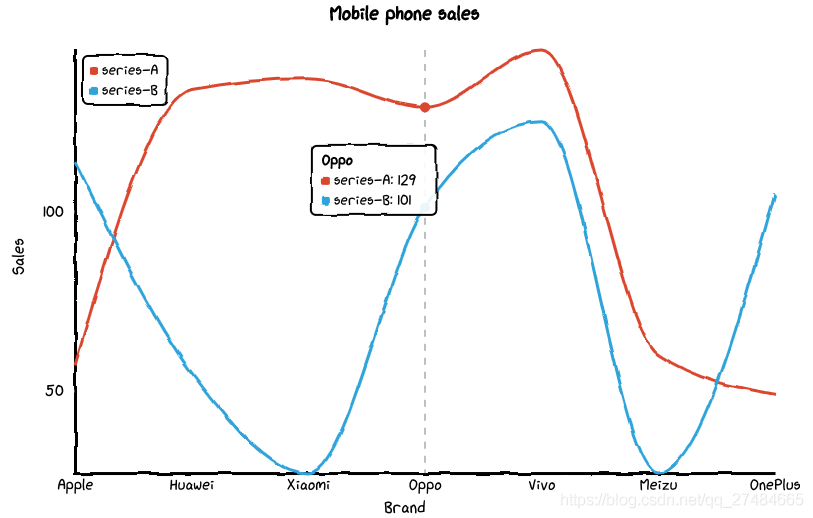
from cutecharts.charts import Line# 虚假数据x_data = ["Apple", "Huawei", "Xiaomi", "Oppo", "Vivo", "Meizu", "OnePlus"]y_data_1 = [57, 134, 137, 129, 145, 60, 49]y_data_2 = [114, 55, 27, 101, 125, 27, 105]
chart = Line("Mobile phone sales")chart.set_options( labels=x_data, x_label="Brand", y_label="Sales", legend_pos="upRight")chart.add_series("series-A", y_data_1)chart.add_series("series-B", y_data_2)chart.render_notebook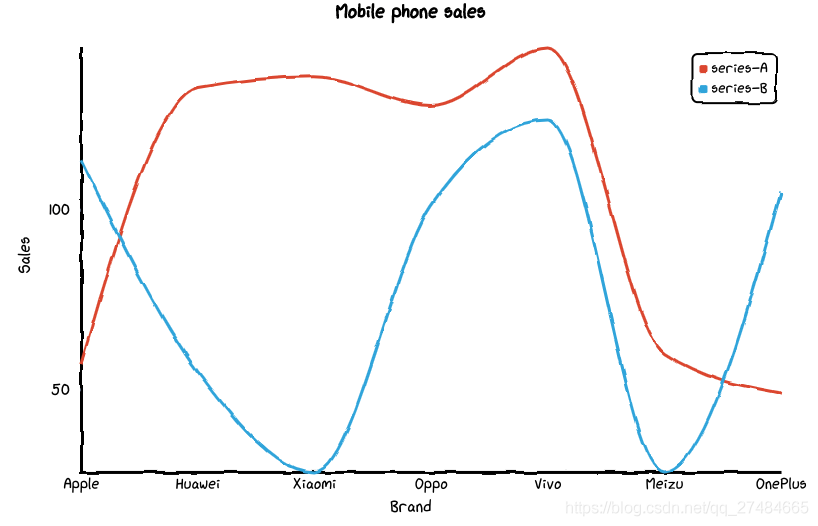
不支持多个系列的数据~
def set_options( self, labels: Iterable, x_label: str = "", y_label: str = "", y_tick_count: int = 3, colors: Optional[Iterable] = None, font_family: Optional[str] = None, ): """ :param labels: X 坐标轴标签数据 :param x_label: X 坐标轴名称 :param y_label: Y 坐标轴名称 :param y_tick_count: Y 轴刻度分割段数 :param colors: label 颜色数组 :param font_family: CSS font-family """
def add_series(self, name: str, data: Iterable): """ :param name: series 名称 :param data: series 数据列表 """# 虚假数据x_data = ["Apple", "Huawei", "Xiaomi", "Oppo", "Vivo", "Meizu", "OnePlus"]y_data = [57, 134, 137, 129, 145, 60, 49]
chart = Bar("Mobile phone sales")chart.set_options( labels=x_data, x_label="Brand", y_label="Sales", colors=Faker.colors)chart.add_series("series-A", y_data)
chart.render_notebook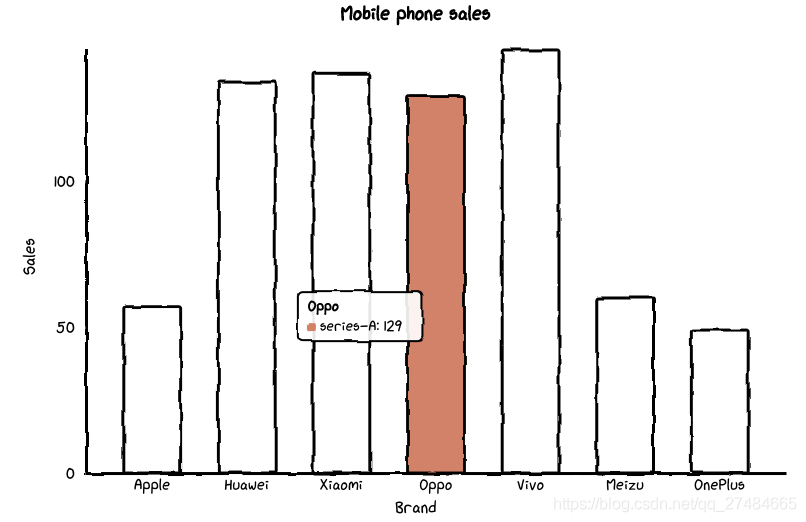
def set_options( self, labels: Iterable, inner_radius: float = 0.5, legend_pos: str = "upLeft", colors: Optional[Iterable] = None, font_family: Optional[str] = None, ): """ :param labels: 数据标签列表 :param inner_radius: Pie 图半径 :param legend_pos: 图例位置,有 "upLeft", "upRight", "downLeft", "downRight" 可选 :param colors: label 颜色数组 :param font_family: CSS font-family """
def add_series(self, data: Iterable): """ :param data: series 数据列表 """# 虚假数据x_data = ["Apple", "Huawei", "Xiaomi", "Oppo", "Vivo", "Meizu", "OnePlus"]y_data = [57, 134, 137, 129, 145, 60, 49]
chart = Pie("Mobile phone sales")chart.set_options( labels=x_data, colors=Faker.colors)chart.add_series(y_data)
chart.render_notebook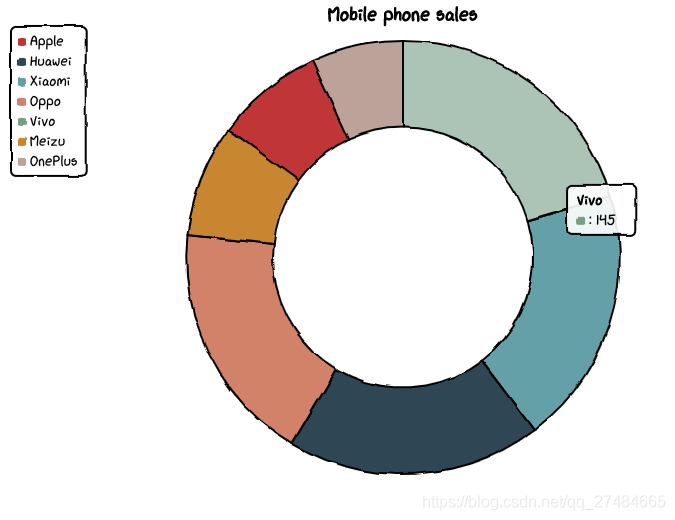
# 虚假数据x_data = ["Apple", "Huawei", "Xiaomi", "Oppo", "Vivo", "Meizu", "OnePlus"]y_data = [57, 134, 137, 129, 145, 60, 49]
chart = Pie("Mobile phone sales")chart.set_options( labels=x_data, inner_radius=0, colors=Faker.colors)chart.add_series(y_data)
chart.render_notebook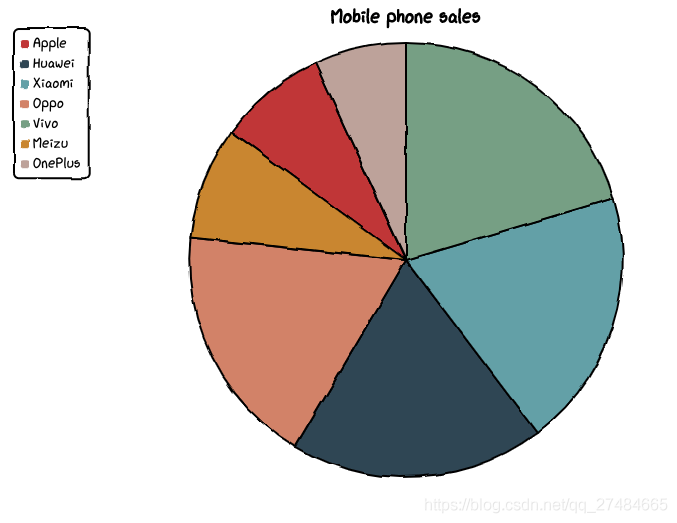
参考代码注释:
def set_options( self, labels: Iterable, is_show_label: bool = True, is_show_legend: bool = True, tick_count: int = 3, legend_pos: str = "upLeft", colors: Optional[Iterable] = None, font_family: Optional[str] = None, ): """ :param labels: 数据标签列表 :param is_show_label: 是否显示标签 :param is_show_legend: 是否显示图例 :param tick_count: 坐标系分割刻度 :param legend_pos: 图例位置,有 "upLeft", "upRight", "downLeft", "downRight" 可选 :param colors: label 颜色数组 :param font_family: CSS font-family """
def add_series(self, name: str, data: Iterable): """ :param name: series 名称 :param data: series 数据列表 """# 虚假数据x_data = ["Apple", "Huawei", "Xiaomi", "Oppo", "Vivo", "Meizu", "OnePlus"]y_data_1 = [57, 134, 137, 129, 145, 60, 49]y_data_2 = [114, 55, 27, 101, 125, 27, 105]
chart = Radar("Mobile phone sales")chart.set_options( labels=x_data, is_show_legend=True, colors=Faker.colors)chart.add_series("series-A", y_data_1)chart.add_series("series-B", y_data_2)chart.render_notebook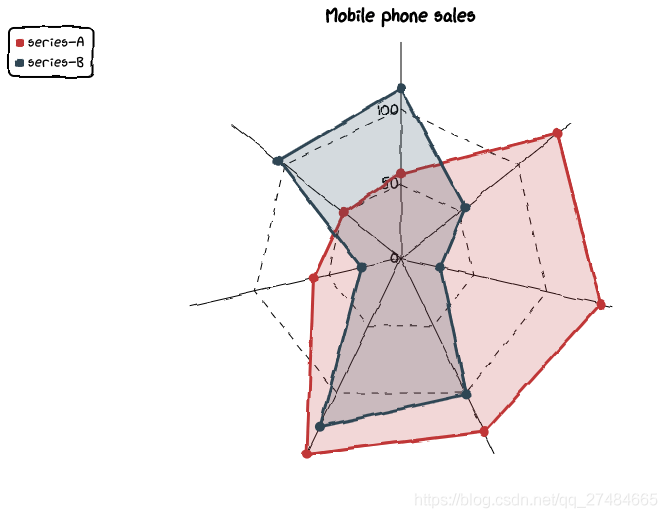
def set_options( self, x_label: str = "", y_label: str = "", x_tick_count: int = 3, y_tick_count: int = 3, is_show_line: bool = False, dot_size: int = 1, time_format: Optional[str] = None, legend_pos: str = "upLeft", colors: Optional[Iterable] = None, font_family: Optional[str] = None, ): """ :param x_label: X 坐标轴名称 :param y_label: Y 坐标轴名称 :param x_tick_count: X 轴刻度分割段数 :param y_tick_count: Y 轴刻度分割段数 :param is_show_line: 是否将散点连成线 :param dot_size: 散点大小 :param time_format: 日期格式 :param legend_pos: 图例位置,有 "upLeft", "upRight", "downLeft", "downRight" 可选 :param colors: label 颜色数组 :param font_family: CSS font-family """
def add_series(self, name: str, data: Iterable): """ :param name: series 名称 :param data: series 数据列表,[(x1, y1), (x2, y2)] """# 随机生成数据data_1 = [(random.randint(0, 100), random.randint(0, 100)) for _ in range(100)]data_2 = [(random.randint(0, 100), random.randint(0, 100)) for _ in range(100)]
chart = Scatter("random dot")chart.set_options( x_label = "I"m x-label", y_label = "I"m x-yabel", x_tick_count = 3, y_tick_count = 3, is_show_line = False, dot_size = 1, legend_pos = "upLeft", colors=Faker.colors)chart.add_series("series-A", data_1)chart.add_series("series-A", data_2)chart.render_notebook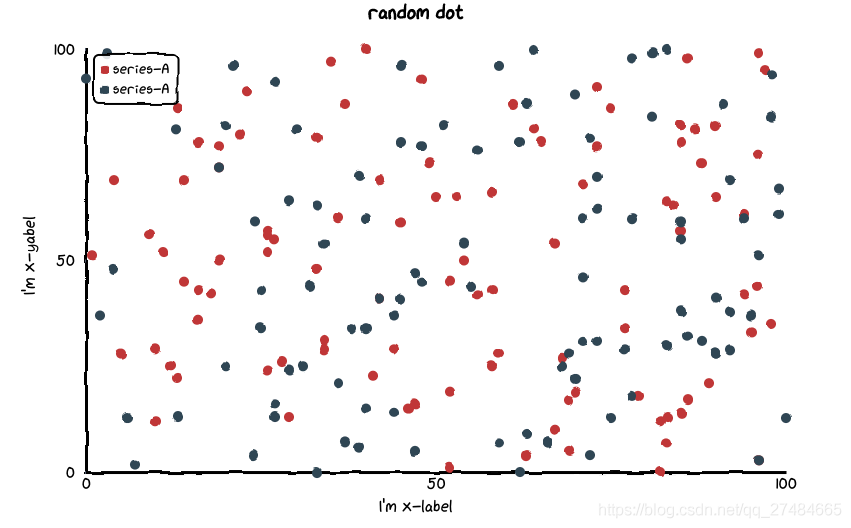
# 随机生成数据data_1 = [(random.randint(0, 100), random.randint(0, 100)) for _ in range(10)]data_2 = [(random.randint(0, 100), random.randint(0, 100)) for _ in range(10)]
chart = Scatter("random dot")chart.set_options( x_label = "I"m x-label", y_label = "I"m x-yabel", x_tick_count = 3, y_tick_count = 3, is_show_line = True, dot_size = 1, legend_pos = "upLeft", colors=Faker.colors)chart.add_series("series-A", data_1)chart.add_series("series-A", data_2)chart.render_notebook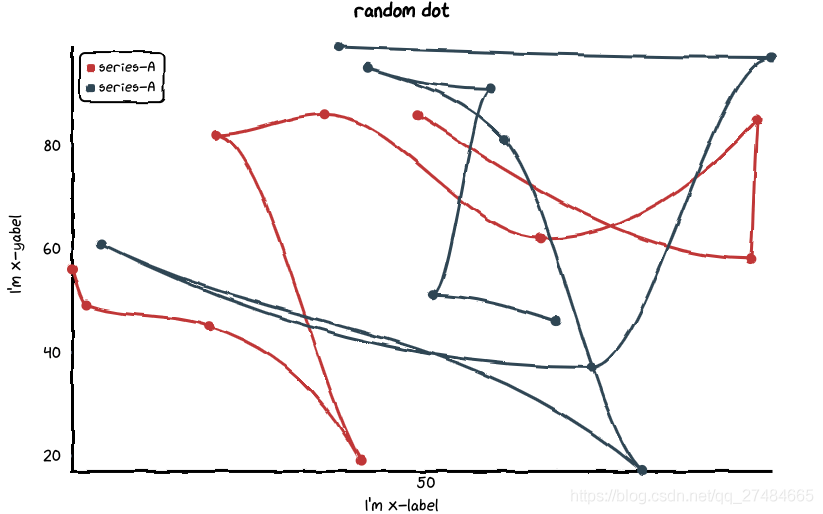
# 虚假数据x_data = ["Apple", "Huawei", "Xiaomi", "Oppo", "Vivo", "Meizu", "OnePlus"]y_data = [57, 134, 137, 129, 145, 60, 49]
chart_1 = Pie("Mobile phone sales")chart_1.set_options( labels=x_data, inner_radius=0.6, colors=Faker.colors)chart_1.add_series(y_data)
chart_2 = Bar("Mobile phone sales")chart_2.set_options( labels=x_data, x_label="Brand", y_label="Sales", colors=Faker.colors)chart_2.add_series("series-A", y_data)
page = Pagepage.add(chart_1, chart_2)page.render_notebook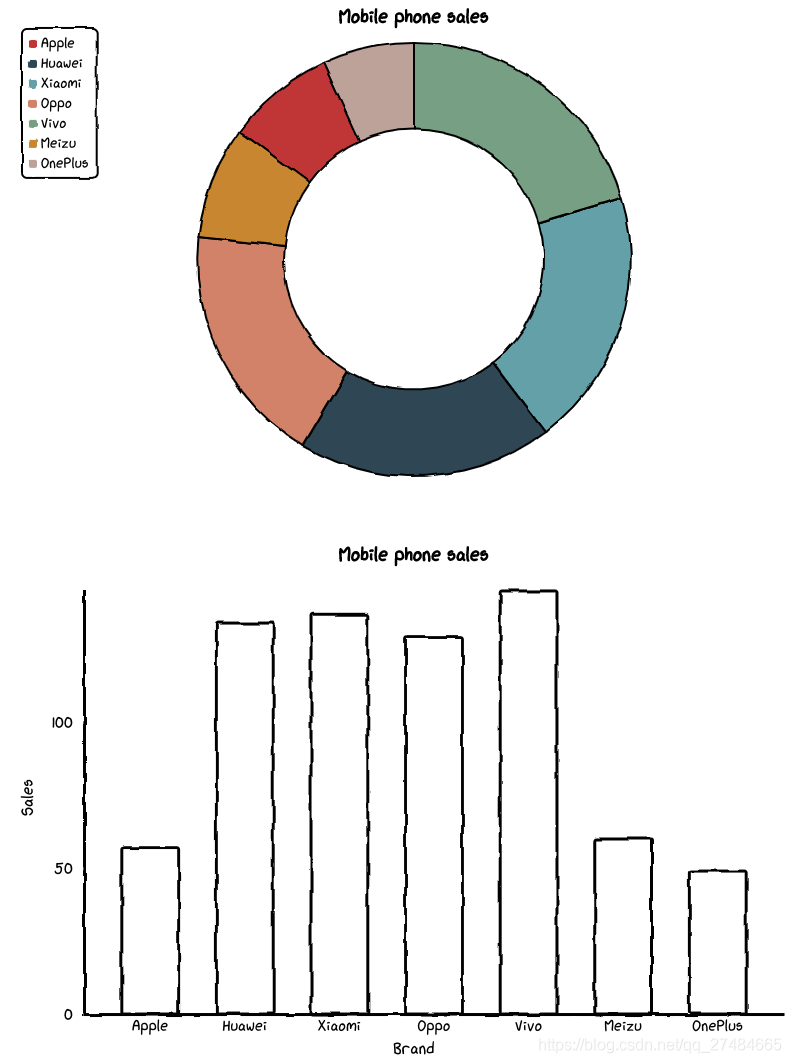
原文链接:https://blog.csdn.net/qq_27484665/article/details/115472329